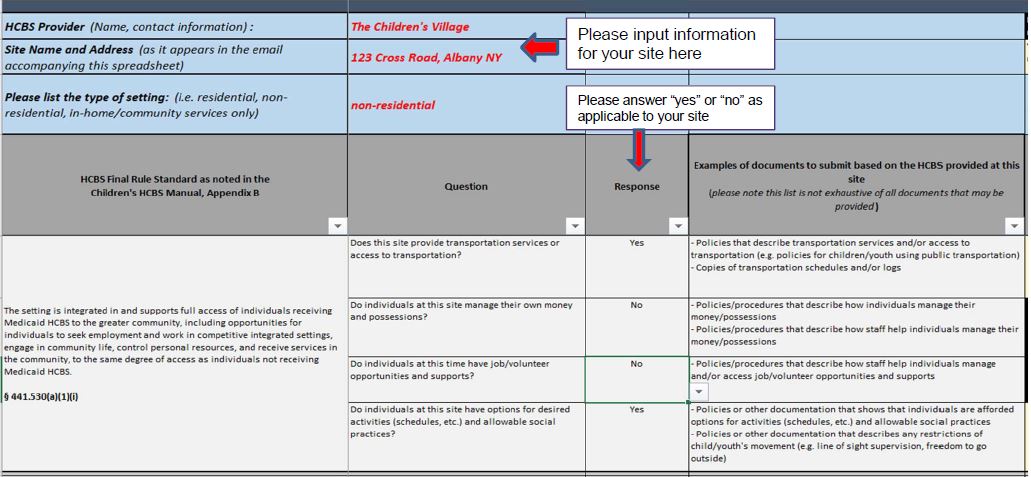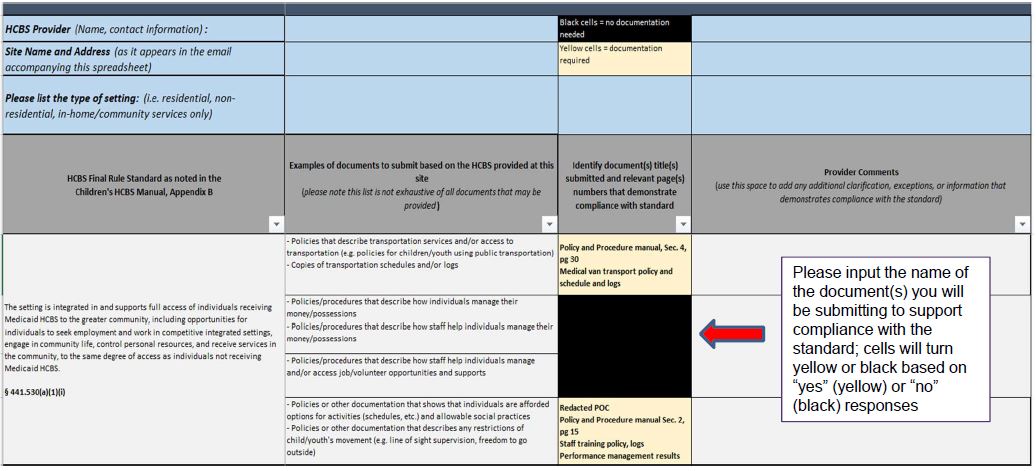HCBS Final Rule Survey Validation and Documentation Request
- Webinar also available in Portable Document Format (PDF)
February 10, 2021
Agenda
- HCBS Final Rule Overview and Standards
- Understanding HCBS Person-Centered Planning
- Assessment of Children's Waiver HCBS Providers for Final Rule Compliance
- Understanding Heightened Scrutiny of the Final Rule
- Next Steps for Achieving Compliance
- Questions and Answers
HCBS FINAL RULE OVERVIEW and STANDARDS
Background on the HCBS Final Rule
- The HCBS Settings Final Rule (Final Rule), a federal Medicaid regulation effective March 17, 2014, set new standards to promote community involvement and independence for people who receive Medicaid- funded home and community-based services (HCBS)
- These federal standards apply to all HCBS provided through New York's 1915(c) waivers, Community First Choice Option, and the 1115 waiver, which includes Managed Care and Managed Long Term Care
- The Rule also set new person-centered planning and conflict of interest requirements
HCBS Final Rule Standards
The Final Rule's standards (rules) for all settings where HCBS are provided Note that settings should:
- ensure that people receive services in settings that are integrated in, and support full access to, their community;
- include opportunities to seek employment and work in competitive settings (i.e., where people receive standard wages) within the community;
- engage in community life, control personal resources, and receive services in a similar way as individuals who do not use HCBS services;
- be selected by the individual from among the options available;
- ensure rights of privacy, dignity, respect, and freedom from coercion and restraint;
- optimize an individual's autonomy and independence in making life choices;
- facilitate an individual's informed choice about their services and who provides them;
- are physically accessible to the individuals supported;
- provide freedom and support for individuals to control their own schedules and activities; and
- provide individuals access to food (meals and/or snacks) and visitors at any time.
The last two standards listed above are the only ones that may be changed or modified, and only on a case-by-case basis for a specific individual:
- When there is a specific need that has been identified that a person requires staff support for (a diagnosis alone is not enough information to support a modification);
- On a time-limited basis (reassessing periodically to see if the modification is still needed);
- After less restrictive and more positive approaches were tried and failed.
UNDERSTANDING HCBS PERSON-CENTERED PLANNING
HCBS Rule: Person-Centered Plan Requirements
The HCBS Final Rule established many new standards in regards to Person-Centered Planning (PCP) such as requiring a person-centered service plan for every person who receives Medicaid-funded HCBS – 42 CFR 441.301(c)(1)
The Person-Centered Plan requirements are included in Section 2402(a) of the Affordable Care Act
Person-Centered Plans must identify individuals':
- Strengths
- Preferences
- Needs (clinical and support)
- Desired outcomes
Person-Centered Plans must also:
- Assist the person in achieving outcomes they define for themselves in the most integrated community settings they desire;
- Be developed through a process where individuals get the right information and support so that they can direct the process as much as possible;
- Document the individual's choice of services and supports they receive and from whom; and
- Document settings options provided that are not specifically designed for people with disabilities.
- Include people in the planning meeting that are chosen by the person served;
- Be updated at least once a year at times and locations convenient to the individual;
- Take into consideration the person's culture and background;
- Use non-technical or plain language, adjusting language as needed;
- Include strategies for solving disagreement(s) and managing risk factors; and
- Provide a method for the individual to request updates.
ASSESSMENT OF CHILDREN'S WAIVER HCBS PROVIDERS FOR COMPLIANCE WITH THE HCBS FINAL RULE
New York's HCBS Site-Level Assessment
The eight State agencies and offices that oversee Medicaid HCBS in New York:
- Have their own existing surveillance and monitoring processes in place to assess for compliance with various State and Federal rules and policies.
- Are building site-level assessment of HCBS compliance into their systems to achieve compliance by March 2023 and monitor compliance going forward.
- Are using a CMS approved process of assessing for compliance of the settings they oversee such as:
- provider self-surveys/attestations, with approved site compliance validation process
- site visits to a statistically significant sample of settings, or
- site visits to all their settings
Childrens Waiver HCBS Site-Level Assessment
DOH will work with HCBS providers to assess Final Rule compliance for all designated sites

Children's Waiver: HCBS Provider Self Assessment Survey
In December 2020, as part of the process to confirm compliance with the CMS HCBS Settings Final Rule, designated children's HCBS providers had to submit a completed self-assessment survey for eachd esignated site.
- Self-assessment surveys were due 12/31/2020
- Approximately 105 HCBS providers and 213 sites
- Currently, surveys are outstanding for 48 sites from 24 providers
CMS requires the State to conduct virtual onsite assessments for each provider site if a 100% survey response rate is not achieved.
Children's Waiver: HCBS Documentation Worksheet
- As part of its efforts to comply with the Final Rule, NYS DOH is requesting documentation and evidence related to each HCBS standard. HCBS providers must submit this documentation in a zip file no later than February 26, 2021 - via the Documentation Worksheet DOH has provided.
- Every HCBS provider will receive an individualized email, with each of the agency's designated HCBS site address(es) listed and labelled (Site 1, Site 2, etc.) Refer to this email while completing the Documentation Worksheet, ensuring the correct site address is listed on the correct site tab of the worksheet.
- One site tab should be completed for EACH HCBS designated site where the agency provides HCBS services.
Children's Waiver HCBS Site-Level Final Rule Compliance Validation Process
Documentation should include, but is not limited to:
- Policies and Procedures such as:
- Legal/financial rights and protection
- Staff training in HCBS policies (may also submit training logs)
- Details of proximity to public transport or other transportation strategies to facilitate registrant's community integration.
- Documentation that the setting is selected by the individual from setting options and is documented in the person-centered plan.
- Documents that individuals' right to privacy are ensured, as well as their dignity and respect and freedom from coercion and restraint.
- Documentation that the program facilitates individual choice regarding services/supports and those who provides them.
Children's Waiver: HCBS Documentation Worksheet Instructions
Please review the worksheet instruction tab before compiling documents and completing the worksheet submission tab.



HCBS SITE REVIEW FOR COMPLIANCE WITH THE HCBS FINAL RULE
Children's Waiver: HCBS Onsite Review
- DOH will identify which settings may need an onsite review to determine their level of compliance. These reviews will be conducted on a representative, statistically significant random sample.
- This sample will be taken from Children's Waiver HCBS residential and non- residential settings. CMS presumes that an individual's home or the home of a family member, friend, or roommate where the individual holds a HCBS compliant lease/agreement, is compliant with the HCBS setting rule.
- Onsite reviews will be conducted virtually using secure video conferencing.
- The site review will require, among other measures:
- A meeting with the provider and touring the setting for observations as to any potential institutional and/or isolating qualities the site may possess;
- Interviews with provider representatives (administration and staff) to understand how the program/residence is structured; and
- Interviews with at least one individual (residents or program participants) to establish if the setting has the effect of isolating individuals receiving HCBS from the broader community.
UNDERSTANDING HEIGHTENED SCRUTINY PROCESS OF THE FINAL RULE
Children's Waiver: Settings Subject to Heightened Scrutiny
The HCBS Rule describes three types of settings CMS presumes to be institutional and therefore subject to heightened scrutiny:
- Settings in a public/privately operated facility providing inpatient institutional treatment (i.e., nursing facility, ICD/IID, IMD, or hospital)
- Settings in a building on the grounds of, or adjacent to, a public institution
- Settings having the effect of isolating individuals receiving Medicaid HCBS from the broader community
Children's Waiver: What is Heightened Scrutiny?
- It is a more intensive form of HCBS site-assessment required by CMS
- Settings with certain characteristics are presumed institutional by CMS
- NYS must submit evidence on those settings if it wants to receive Federal Financial Participation (FFP) for those settings past the 2023 deadline
- Evidence for each setting is required to go through a public comment period
- Providers that are identified will be individually contacted, and DOH will provide additional information on next steps.
Children's Waiver: Required Reporting for Heightened Scrutiny
- Sites either located in a building or on the grounds of a facility also providing inpatient institutional treatment, or otherwise presumed institutional under the Final Rule are submitted to CMS for heightened scrutiny by March 31, 2021.
- A setting found to isolate individuals from the broader community, which implements remediation strategies bringing it into compliance with the Final Rule by July 1, 2021, will not need to be submitted to CMS for a heightened scrutiny review.
- DOH must submit to CMS isolating settings that have not completed necessary remediation for a heightened scrutiny review by October 31, 2021
NEXT STEPS FOR ACHIEVING COMPLIANCE WITH THE HCBS FINAL RULE
Next Steps for Achieving Compliance
DOH will work with Children's Waiver HCBS providers to draft remediation strategies and a corresponding timeline for resolving issues identified by the assessments conducted. Providers will have until March 2023 to come into compliance with the HCBS Final Rule.
Some changes that Children's Waiver providers can and are making, are:
- Increasing flexibility and options for individualized activities and outings, rather than only offering on-site activities or group outings
- Adding snack cabinets/cubbies, making snacks available at any time
- Making visiting hours unrestricted, adding a visitors room with a phone
- Giving registrants who are competent access to come and go freely with key codes/cards/etc.
Enhancing person-centered planning and plan implementation:
- Eliminate blanket program rules/restrictions and use required process to make modifications to HCBS standards on a case-by-case basis
- Use plain language in all documents
- Include goals important to the person (meaningful activities, relationships, etc.) balancing them with to those important for them (health, safety, etc.)
Key Upcoming Dates
- Requested documentation demonstrating Final Rule compliance due to DOH by February 26, 2021.
- Sites located in a building or on the grounds of a facility or otherwise considered institutional, submitted to CMS for heightened scrutiny by March 31, 2021.
- DOH validation of Final Rule compliance and site reviews completed by May 2021.
- Setting found to isolate individuals from the broader community, must implement remediation strategies bringing it into compliance by July 1, 2021.
- Isolating settings which have not completed remediation are submitted to CMS by October 2021.
- Full compliance with the HCBS Final Rule is March 17, 2023.
QUESTIONS AND ANSWERS
Additional Resources
- To learn more and register for training opportunities that will support your organization's HCBS Final Rule compliance activities go here.
- For more information on New York's HCBS Statewide Transition Plan to come into compliance with the HCBS rule go here
- Childrens Waiver HCBS Documentation Worksheet
- For additional questions about the Children's Waiver HCBS compliance validation process, please email us at: ChildrensWaiverHCBSFinalRule@health.ny.gov